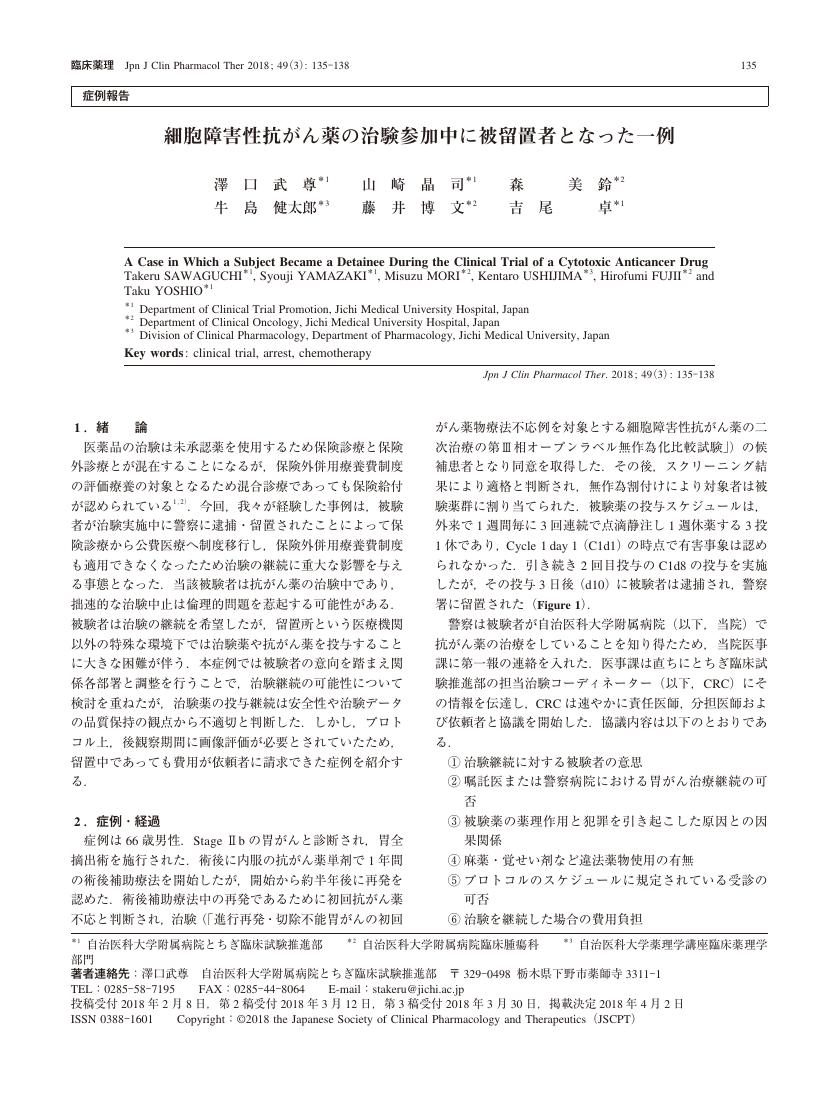3 0 0 0 細胞障害性抗がん薬の治験参加中に被留置者となった一例
- 著者
- 澤口 武尊 山崎 晶司 森 美鈴 牛島 健太郎 藤井 博文 吉尾 卓
- 出版者
- 一般社団法人 日本臨床薬理学会
- 雑誌
- 臨床薬理 (ISSN:03881601)
- 巻号頁・発行日
- vol.49, no.3, pp.135-138, 2018-05-31 (Released:2018-06-21)
- 参考文献数
- 4
2 0 0 0 退院時のステロイド量と退院後の感染症発症率
- 著者
- 青木 葉子 岩本 雅弘 木村 洋貴 長嶋 孝夫 吉尾 卓 岡崎 仁昭 簔田 清次
- 出版者
- 自治医科大学
- 雑誌
- 自治医科大学紀要 (ISSN:1881252X)
- 巻号頁・発行日
- vol.30, pp.29-36, 2007
Objective Prednisolone has traditionally been tapered below 30 mg daily before patients are discharged from hospitals in Japan because of concerns regarding the development of infectious complications. We undertook this study to compare the incidence of infectious complications in patients taking more than 30 mg of prednisolone daily with those taking less than 30 mg. Patients and Methods The medical records of fifty-seven patients with systemic lupus erythematosus (SLE) were reviewed retrospectively, and divided into three groups based on the dose of glucocorticoids at the time of discharge: group A (n=13), newly-diagnosed SLE patients taking more than 30 mg of prednisolone daily; group B (n=22), newlydiagnosed SLE patients taking less than 30 mg; and group C (n=22), patients with an established diagnosis taking more than 30 mg daily for the treatment of an exacerbation of symptoms. The development of infectious complications within two months after discharge was identified from a review of the medical records to determine the effect of glucocorticoid dose at the time of discharge on the subsequent development of infectious complications. Results Two patients in group A and three in group C developed infectious complications within two months following discharge, while no patients in group B contracted an infection. These included herpes zoster in group A (n=2) and herpes zoster, urinary tract infection and Pneumocystis jirovecii pneumonia in group C (n=3, one each). However, the incidence of infectious complications comparing groups A and B, and groups A and C was not statistically significantly different( p>0.05). There was no correlation between the incidence of infection and the total dose of glucocorticoids given during admission.Conclusion Although this study was retrospective and involved only a small number of patients with SLE, there is no increased risk of developing infectious complications in pa-tients receiving more than 30 mg of prednisolone daily at the time of hospital discharge, compared to those taking less than 30 mg. Based on these results, prolonging hospitalization only to reduce the dose of prednisolone to less than 30 mg daily lacks justifiable grounds, even if it has been a tacit consensus in Japan.
1 0 0 0 OA 中枢神経ループスの診断及び活動性マーカー確立の為の研究
1.CNSループス出現頻度の検討(栃木県モデル)栃木県3医療機関で前向きに3年間、年度毎のSLE患者数、CNSループス発症頻度と症状内訳を調査研究した。SLE登録患者は開始時719例、終了時823例、栃木県人口に対するSLE患者有病率は0.041%であった。10年度12例、11年度16例、12年度15例がCNSループスの診断を受け、半数以上がSLE発症直後に出現し、症状内訳は約7割がループス精神病であった。2.CNS ループス診断に有用なCSFcytokine/chemokine (cy/ch)の検討SLE患者でCSFと血液採取が同時に行われた52例(CNSループス陽性群30例、陰性群22例)のCSFと血清の28種類cy/ch測定を行った。陽性群のCSFIL-6、IL-8、IP-10、MCP-1、G-CSF濃度が血清の各々に比較して高値を示し、陽性群と陰性群でのこれらCSF濃度比較検討では陽性群が有意に高値を示した。特にIL-6の有意差が最も大きく、CSF IL-6濃度測定がCNSループスの診断に最も有用で
